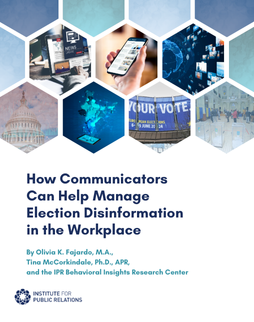Rejoice. You can now cite proof that a media placement has the same effectiveness as advertising. But not more than that – at least not yet.
In a new Institute-sponsored study entitled “Exploring the Comparative Communications Effectivess of Advertising and Media Placement,” David Michaelson (David Michaelson & Co., LLC) and Don W. Stacks (University of Miami) designed an experiment to test a long-held, oft-repeated assumption. Namely, that editorial coverage generated through public relations has greater value than equivalent advertising – some practitioners claim three or more times greater.
The researchers (following their own pilot study in 2004, which was sponsored by PRtrak, now part of VMS) “created” a new product for this experiment to eliminate pre-existing biases about specific brands. The product was a snack food called “Zip Chips” with no sodium or fats. A print ad and a news article were developed with parallel messages.
These materials were tested in five mall locations across the US. A sample of 351 adults who read a newspaper at least once a week was divided into three groups: those exposed to advertising only, those exposed to the news article only, and a control group. A questionnaire was used to determine if editorial coverage and advertising perform differently on key measures ranging from credibility and brand image to purchase intent.
The researchers found no statistically significant differences on almost all measures: brand recognition, message believability, overall interest or consumer preference. The article readers, however, perceived that they had received more information than the ad readers. The article also scored better on measures of whether the respondents thought they could personally relate to the product.
Should we be disappointed that public relations did not score higher than advertising on more measures? The researchers say that the results reinforce the importance of delivering product messages through a variety of channels. With PR-generated publicity being the clear equivalent of advertising, it may be cost-effective to shift more resources to public relations.
Also, keep in mind that the experiment involved one exposure for a consumer product. What about situations involving multiple exposures? What if it’s not a consumer product, but a corporate reputation or public policy issue? What if the messages are not equivalent, or interactive media are involved?
Michaelson and Stacks say we should stay tuned for more research in this area.
Click here for full research presentation.
Frank Ovaitt
President and CEO
Institute for Public Relations




I think it’s entirely misleading to conclude from this controlled study of 351 newspaper readers that “PR-generated publicity is the clear equivalent of advertising.”
For example, advertising can place many messages in selected media. Publicity usually appears once. Once the Daily Blast has run your story, that it, until something else newsworthy happens. In the meantime, you can advertise as often as your budget permits. Frequency, placement, and message control have long been a crucial difference between advertising and PR-generated publicity messages, and I don’t see how this study changes anything.
Thanks for your feedback, Glen. I want to be clear that the Institute has long stood for the broadest possible understanding of the term public relations as a management function. I personally feel it’s a shame that over the last three to four decades ( think post-Watergate and ‘modified limited hangout’ ), we didn’t stand and fight for the good name of our profession instead of moving toward terms like corporate communications, corporate affairs, corporate relations, etc. Those are elements of a larger professional realm – as are media relations and story placements – that at its best focuses on building relationships that matter to organizations and stakeholders.
In the overall context of this particular study and Conversations column, it would seem obvious that we were referring to media relations or media placement, and not equating that alone to the term public relations. But we were not so careful in the title of the study and the title of my message. We’ll try to do better in the future.
After years of progress in redefining and expanding the concept of public relations to a management function, I am saddened to see the Institute and my colleagues revert to defining public relations as simply publicity. Marketing and public relations both use advertising and publicity, as do the legal, human resources and investor relations functions.
Apparently, the study reported here represents a marketing effort “delivering product messages” as part of a promotional campaign to gain “exposure for a consumer product.” That’s the sales promotion part of a marketing program, not a public relations effort.
Why is it so often one step forward and two steps backward for our field? This Institute release (publicity) is not the kind of “PR for PR” that so many call for. I urge you not to buy an advertisement to extend the reach of this message.
Glen Broom, Ph.D.
School of Communication
San Diego State University